This post may contain affiliate links. Please read our disclosure policy.
Learn how to easily make chewy and springy alkaline noodles with just a handful of ingredients using lye water (kan sui). The recipe includes both egg and eggless version.

What is alkaline noodles (Jian Shui Mian)?
Alkaline noodles, also known as “ramen noodles” or “alkaline ramen noodles,” or “Jian Shui Mian” are characterized by their unique texture and color. These noodles are made using alkaline water, often known as lye water or kan sui. It is an essential ingredient in making alkaline noodles like ramen noodles and various Chinese egg noodles. Kansui helps give these noodles their characteristic texture, color, and flavor.
What is alkaline water/lye water/kan sui?
Kansui is traditionally made by filtering water through ashes of certain hardwoods, such as oak or beech, which contain natural alkaline minerals. The resulting water becomes alkaline and imparts unique properties to the dough, such as increased elasticity and a slightly yellowish hue. This alkaline environment affects the proteins and starches in the dough, resulting in the distinct chewy and springy texture of noodles made with kansui.
In modern times, commercially produced kansui is also available, which is essentially a solution of potassium carbonate and sodium bicarbonate in water. This can be a convenient way to incorporate the alkaline properties into dough when making noodles.
Is alkaline water safe to use in food?
The amount of alkaline water is usually only needed in small amounts. Alkaline water, which has a higher pH than regular water due to the presence of alkaline minerals or compounds, is often used in cooking to create specific textures and flavors in dishes like alkaline noodles. So, in general, it is safe to consume in a reasonable amount.
Can I make alkaline noodles without alkaline water/lye water?
Yes, you will see many recipes use baked baking soda instead of lye water. Lye water is usually available in Asian grocery store, but I know some people still have trouble finding it. I haven’t tried making these alkaline noodles using baked baking soda though. So if you don’t have alkaline water, you can google up alkaline noodles recipe that uses that instead of alkaline water.

Homemade Alkaline Noodles/Ramen Noodles (Jian Shui Mian)
Ingredients
Dough without egg:
- 350 g all-purpose flour plus more for dusting
- 1 tsp salt
- 15 g oil
- 150 g water or more as needed
- 1 ½ tsp lye water
Dough with egg:
- 350 g all-purpose flour plus more for dusting
- 1 tsp salt
- 15 g oil
- 50 g egg from 1 medium-size egg
- 120 g water or more as needed
- 1 tsp lye water
Instructions
Prepare the dough:
- In a large mixing bowl, whisk water, oil, egg (if using), and lye water to combine. Add the flour and salt. Stir with a chopstick at first to form uneven granules of flour mixture, then use your clean hands to mix into ragged-looking dough. As long as you can form a rough dough, eventhough if it's at a dry side, it's okay. This dough is meant to be at a dry side. Don't be tempted to add too much liquid.
Rest the dough:
- Cover the mixing bowl and let it rest for 1 hour
Finalize preparing the dough:
- After the 1-hour rest, the dough won't be as dry anymore. Use your clean hands to give it a few kneadings. It will smooth out more, but it won't be a perfectly smooth dough, which is what it supposed to be
Roll the dough into sheets:
- I use a pasta roller to get the job done much easier. I divide the dough into two masses. Cover the other and work with one at a time. Flatten the dough with a rolling pin, about 1/2-inch or a bit less so it can pass through the roller. Dust the flattened dough lightly with some flour. I use Kitchen Aid pasta roller and it has 8 settings. I start with setting no. 1, which is the thickest setting used to "knead" and thin the dough.
- Fold the dough in half and then pass through the roller. Repeat this step several times. Then reduce the setting to 2 and then fold the dough in half again lengthwise and pass through the roller. Do this maybe 2-3 more times. I actually stop at 2 because my kids like this thickness, but most people would reduce the thickness to one more level, which is setting no. 3.
- You are welcome to adjust the thickness the way you like it and with each setting, just fold the dough in half lengthwise and pass through the roller 2-3 times. Dust the noodle sheet with some flour
- Repeat with another dough to roll into dough sheets
Cut the dough:
- If you plan to cook the noodles right away, bring a large pot of water to a boil before you start cutting the noodles. Make sure you have a large pot of water. If you cook the noodles in too little water, the noodles will come out having a glue-like texture and very starchy. So you want to make sure the water is boiling and the amount of the water is enough to cook the noodles to get rid of the extra flour we dusted on the dough when we prepare the dough
- Liberally dust the noodle sheets with some flour to prevent the noodle strands from sticking to each other during cutting. I use the spaghetti cutter. Pass the noodle sheet through the cutter and catch the noodles as it comes out from the cutter. Dust with some flour to prevent sticking
Cook the noodles:
- The large pot of water should have come to a full boil by now. Add a pinch of salt. Loosen the noodle strands using your hands and add them into the boiling water and use a chopstick to gently loosen the noodles to prevent them from clumping to each other. Let the water comes back to a boil and cook for another minute. The total cooking time would be about 3 minutes or less. It is important not to overcook the noodles
- Drain the cooked noodles through a heat-proof colander or strainer. Rinse the noodles through a cold running water to stop the cooking process and to remove extra starches. You can toss the cooked noodles in a bit of oil
- The cooked noodles are ready to be used, for mixing with sauces, stir-frying, or noodle soup
If not cooking the noodles right away:
- For this recipe, I separate the cut noodles into about 4 separate piles. I place them on a baking sheet lined with parchment paper. Put them in a freezer to flash freeze them for about 1 hour. It won't be completely frozen but they are firmed enough to be transferred to a freezer bag or container. Push all the air out if using a freezer bag, seal the bag and store in the freezer for up to 1 month
- I do not recommend storing the uncooked noodles in the refrigerator as the noodles can get mushy because of moisture accumulates
To cook frozen noodles:
- It's similar to the cooking step above, which is bringing a large pot of water to a boil. You don't need to thaw the frozen noodles
- Important tips: when cooking frozen noodles, remember not to "stir" the noodles the first 10-15 seconds when you just drop the noodles into the water. Because the noodle is still frozen and break easily. Stirring it will break the noodles into little pieces, which you don't want
- After that you can use a chopsticks to gently loosen the noodles a bit to separate them so they won't clump all together. Continue cooking until the water comes to a boil again and cook for another minute. Do not overcook the noodles
- Drain the cooked noodles through a heat-proof colander or strainer. Rinse the noodles through a cold running water to stop the cooking process and to remove extra starches. You can toss the cooked noodles in a bit of oil
- The cooked noodles are ready to be used, for mixing with sauces, stir-frying, or noodle soup
RECOMMEDED TOOLS
*Nutrition facts are just estimates and calculated using online tools*
How to make alkaline noodles at home from scratch
1. In a large mixing bowl, whisk water, oil, egg (if using), and lye water to combine. Add the flour and salt. 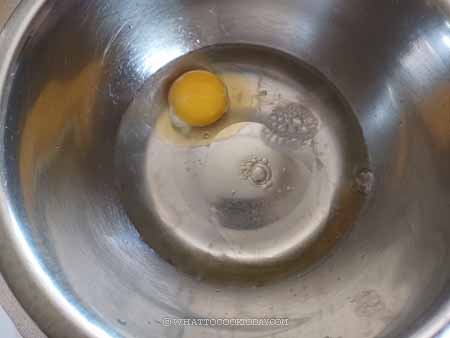
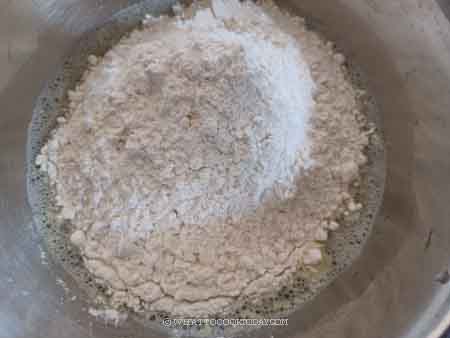
2. Stir with a chopstick or a spatula at first to form uneven granules of flour mixture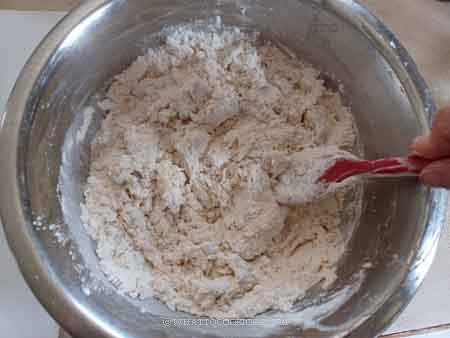
3. Then use your clean hands to mix into ragged-looking dough. As long as you can form a rough dough, eventhough if it’s at a dry side, it’s okay. This dough is meant to be at a dry side. Don’t be tempted to add too much liquid.
4. Cover the mixing bowl and let it rest for 1 hour. The dough on the left is made with egg (the color is more golden yellow), and the one on the right is without egg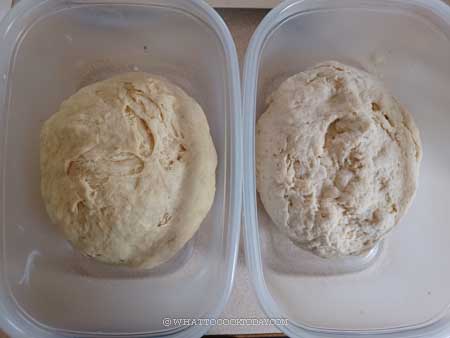
5. After the 1-hour rest, the dough won’t be as dry anymore. Use your clean hands to give it a few kneadings. It will smooth out more, but it won’t be a perfectly smooth dough, which is what it supposed to be.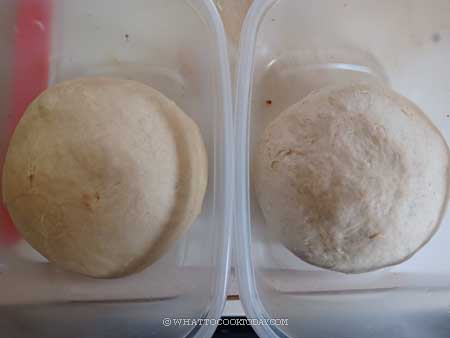
6. I use a pasta roller to get the job done much easier. I divide the doughs into four masses (2 for each dough since I made one with and one without an egg). 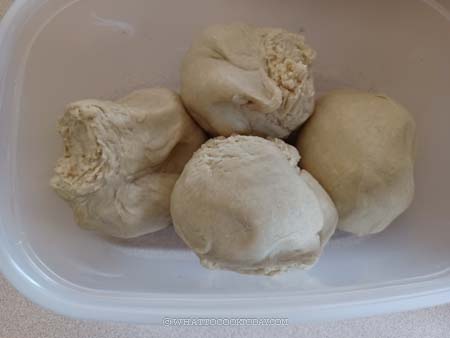
7. Cover the other and work with one at a time. Flatten the dough with a rolling pin, about 1/2-inch or a bit less so it can pass through the roller. Dust the flattened dough lightly with some flour. I use Kitchen Aid pasta roller and it has 8 settings. I start with setting no. 1, which is the thickest setting used to “knead” and thin the dough.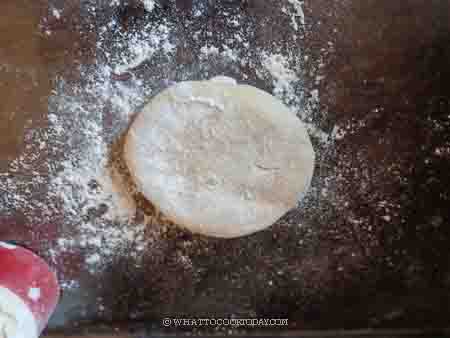
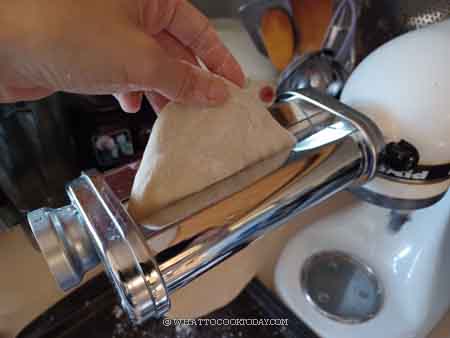
8. Fold the dough in half and then pass through the roller. Repeat this step several times. Then reduce the setting to 2 and then fold the dough in half again lengthwise and pass through the roller. Do this maybe 2-3 more times. I actually stop at 2 because my kids like this thickness, but most people would reduce the thickness to one more level, which is setting no. 3.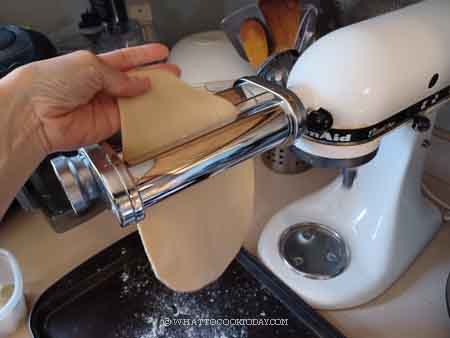
9. You are welcome to adjust the thickness the way you like it and with each setting, just fold the dough in half lengthwise and pass through the roller 2-3 times. Dust the noodle sheet with some flour. Repeat with another dough to roll into dough sheets
10. If you plan to cook the noodles right away, bring a large pot of water to a boil before you start cutting the noodles. Make sure you have a large pot of water. If you cook the noodles in too little water, the noodles will come out having a glue-like texture and very starchy. So you want to make sure the water is boiling and the amount of the water is enough to cook the noodles to get rid of the extra flour we dusted on the dough when we prepare the dough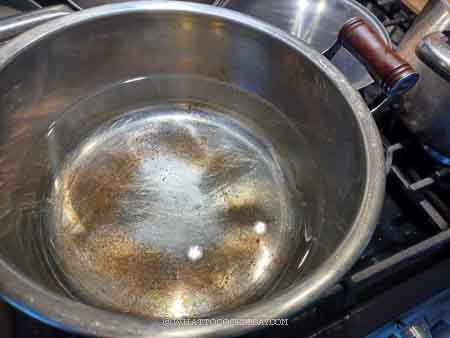
11. Liberally dust the noodle sheets with some flour to prevent the noodle strands from sticking to each other during cutting. I use the spaghetti cutter. Pass the noodle sheet through the cutter and catch the noodles as it comes out from the cutter. Dust with some flour to prevent sticking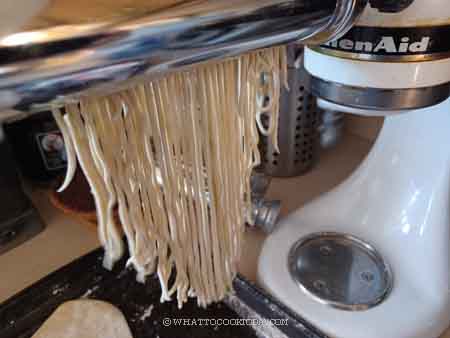
12. The large pot of water should have come to a full boil by now. Add a pinch of salt. Loosen the noodle strands using your hands and add them into the boiling water and use a chopstick to gently loosen the noodles to prevent them from clumping to each other. Let the water comes back to a boil and cook for another minute. The total cooking time would be about 3 minutes or less. It is important not to overcook the noodles
13. Drain the cooked noodles through a heat-proof colander or strainer. Rinse the noodles through a cold running water to stop the cooking process and to remove extra starches. 
14. You can toss the cooked noodles in a bit of oil. The cooked noodles are ready to be used, for mixing with sauces, stir-frying, or noodle soup
How to make ahead
1. I do not recommend storing the uncooked noodles in the refrigerator as the noodles can get mushy because of moisture accumulates
2. For this recipe, I separate the cut noodles into about 4 separate piles. I place them on a baking sheet lined with parchment paper. Put them in a freezer to flash freeze them for about 1 hour. It won’t be completely frozen but they are firmed enough to be transferred to a freezer bag or container. Push all the air out if using a freezer bag, seal the bag and store in the freezer for up to 1 month
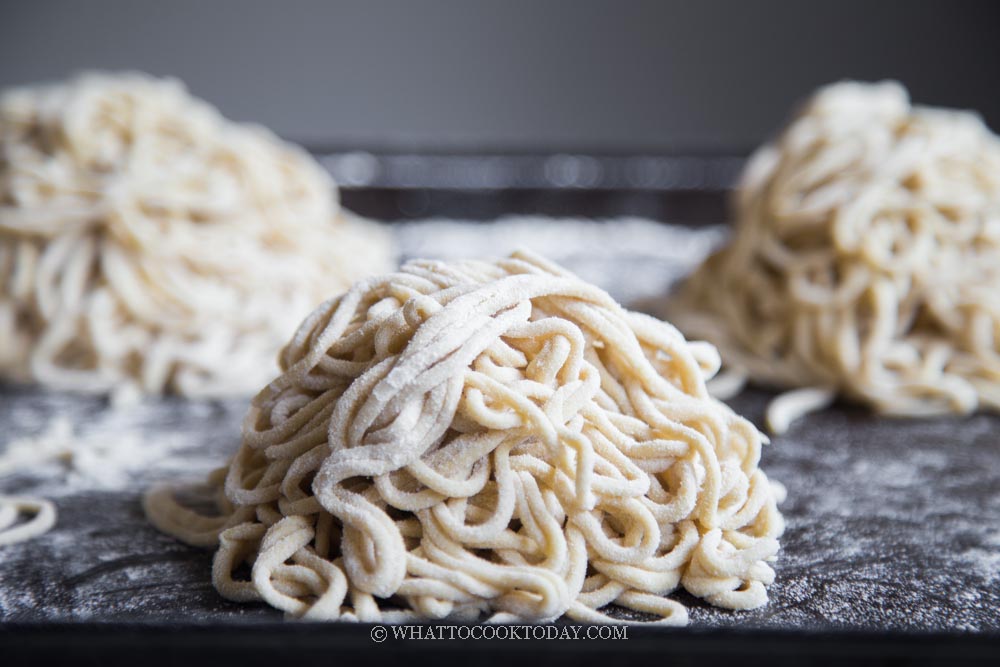
Did you make this homemade alkaline noodle (jian shui mian) recipe?
I love it when you guys snap a photo and tag it to show me what you’ve made Simply tag me @WhatToCookToday #WhatToCookToday on Instagram and I’ll be sure to stop by and take a peek for real!


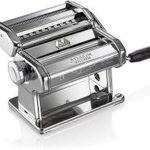
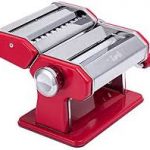

6 comments
Just did them and they came out quite nice. Thank you for the recipe! I’ve made lye water myself with baked baking soda, so if anyone is doing the same you need to use a ratio of 1:4, i.e. 1 part baked baking soda to 4 parts water. So for 1 teaspoon of lye water, mix 1/4 teaspoon baked baking soda with 1 teaspoon water.
Was amazing! Thanks!
Thank you for sharing your homemade lye water hack Lili! 🙂 and for your feedback too!
Thank you for taking time to explain how to make noodles with kansui.
I’m glad you find it useful Jerry!
Can you make a recipe for Kuching yam puff? It’s not the same as wukok, the filling is white and creamy and the skin is flaky and buttery instead of crispy.
Hi Sarah, I have never had Kuching yam puff before. Do you by any chance have the image?